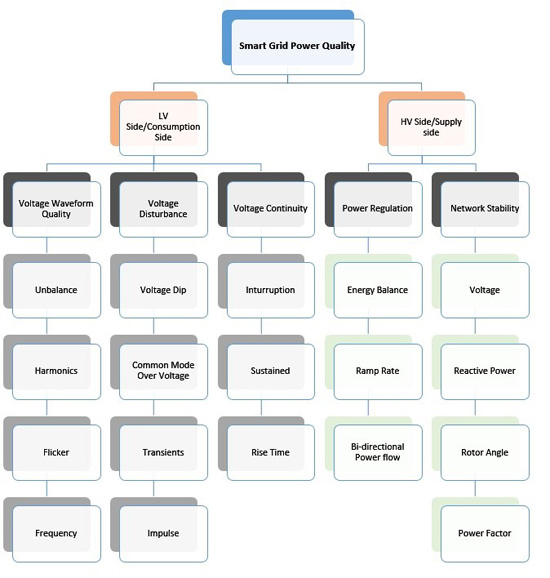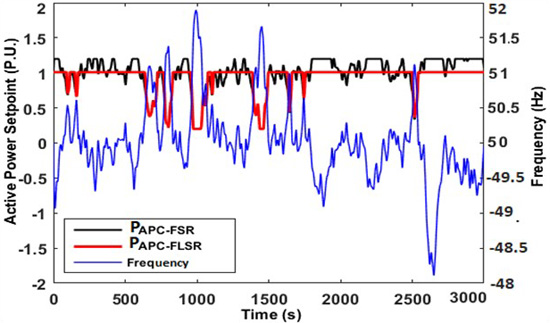Maintaining Power Quality in Smart Grid: The Wind Farms Contribution
By Asma Aziz, Ameen Gargoom and Aman MTO
Necessity and importance of ensuring sustainable, secure, and affordable supply of electricity is undeniable. Power systems around the world are undergoing the continuous shift from centrally dispatched large-scale synchronous generation towards smart grids incorporating intermittent renewable and distributed generation. This change in the generation mix has implications for the whole interconnected system designs, its operational strategies, and the regulatory framework. Though there is no single solution, the smart, responsive grid is undoubtedly the significant proactive investment for the safe energy future. With the increasing number of wind farms integrated at both distribution level as well as transmission levels, they have a unique role to play in future smart grids in maintaining the power continuity and energy balance as part of power quality. This article highlights the capability of modern wind farms to regulate the grid frequency to maintain the energy balance, which is an essential criterion of good power quality in a smart and responsive grid.
Power Quality Issues
Diverse opinions and understanding of the power quality issues led to different classifications. Though power quality (PQ) is generally referred in terms of the electric supply provided at the consumer end, the term is also significant from utility or supply-side perspective in terms of maintaining the grid reliability. Utility companies, as well as network users with grid technologies and customer side technologies, respectively are all affected with the PQ issues. Figure 1 presents various terms associated with the power quality both at the distribution side/consumer side and transmission side/supply side. There is a coupling between the power quality requirements of maintaining frequency as part of energy balance and the commercial interest in the uninterrupted electric supply. Without frequency control, the grid is unable to operate without an unacceptably high risk of equipment damage and blackouts.

Fig. 1: Power quality issues as know at the consumption side and supply side
With increasing participants in the grid, there is a rise in the associated issues for maintaining the continuous electric supply as a vital component of the power quality. Hence, the successful implementation of the smart grid will depend upon the investigation and benchmarking the power regulation capability of the various technologies at both the transmission side as well as distribution side of the grid. Modern wind farms are being integrated at both the transmission as well as distribution level of the grid, and they have a special role to play in future smart grids in maintaining the power continuity as part of the power quality.
Power continuity in the smart grid through frequency responsive wind power plants: State of the art
Various small contingency events in a small islanded grid may aggravate into one big contingency event leading to power outages in the absence of any frequency control services. Frequency control services require automatic as well as commanded additional power support from generating units in response to the frequency disturbances. Additional power contribution from wind farms during any contingency event was earlier only desired in small islanded electrical grids. However, with impending system inertia reduction and mandatory frequency support requirements to support smart grid power quality services in many countries, modern VSWTGs are now incorporating augmented power control technologies. Frequency-power control functionalities are auxiliary control technology implemented in the individual WTGs as well as the farm controller for providing controllable power reserve on demand. Continuous monitoring of the grid frequency is implemented, and noiseless frequency is added as an input to the wind farm frequency controller to generate power setpoint (P_APC). Generated power setpoint incorporates power ramp limitation considering available wind power, rated turbine power, generator droop characteristic and transmission system operator (TSO) commanded power and is then provided to the turbine controller to deliver the power order. Grid code compatible modern wind farms are now capable of responding to the TSO's automatic generation control (AGC) commands during under and over frequency events by providing frequency sensitive response (FSR) and frequency limited sensitive response (FLSR) at an increased ramp rates as shown in Figure 2. During frequency sensitive response (FSR) mode, wind farm generates proportional power to both up and down frequency deviations as per the generated active power setpoints. During frequency limited sensitive mode, wind farms provides proportional power output only when the grid frequency exceeds the set upper limit.

Fig. 2: Active power setpoint generated in VSWTG when employing the frequency response controller
Although these grid codes compatible advanced wind farms are participating in the frequency control services in some European countries like Denmark and U.K., countries like Australia are looking forward to activating these services in its grid for better power quality. Currently, HWF2 is the first Australian wind farm to be registered for offering frequency responsive services in the energy market. Figure 3 shows the proof of concept trail active power response of HWF2 between 2200 hrs and 2230 hrs on 19 December 2017. The HWF2 was able to follow the AGC setpoints precisely and provided 20 MW of raise regulation and 20 MW of lower regulation services at a steady wind speed of 10-11m/s.
![Fig. 3: HWF2 regulation FCAS performance [2]](/images/files/newsletter/june19-03-03.jpg)
Fig. 3: HWF2 regulation FCAS performance [2]
Wind farm power-frequency response capability benchmarking and deployment in the smart grid
IEEE P1159, AS/NZS 61000.3.2.2003, ANSI C84.1, EN 50160, IEEE 1459, EN 50160, and IEC 61000 are some of the vital power quality standards with a general focus on the distribution side. However, the majority of the network participants still lack reliable monitoring, regulation methods, and compliance of PQ benchmarking at the transmission side of the network. Evolving power system towards smart grids with distributed energy resources has necessitated some of the power quality issues and related standards to be updated. IEEE 1547 is currently the only standard discussing the interconnection, interoperability in terms of power frequency regulation and related power quality issues between distributed generations and conventional generations. According to the recently updated IEEE 1547-2018 standard, the distributed energy resources shall now have the capability of mandatory operation with frequency-power provision during low-frequency ride-through and high-frequency ride-through to maintain power supply continuity.
Benchmarking the frequency-power response capability of wind farms will support their deployment at a broader scale and improve the overall power quality of the grid. Benchmarking of the power response capability from wind farms require appropriate modeling of the grid including wind farm for fast raise power-frequency response; implementation of fast and dedicated communication links between wind farms and TSO and on-site plant testing results. Wind farms testing response must demonstrate the capability to be remotely controlled by the transmission grid operator under the fastest possible time. Testing results must also demonstrate the power generation response to a frequency disturbance, which is coinciding with a voltage disturbance. Advanced forecasting of wind and demand within less than 5 minutes time frame will further strengthen the capabilities of frequency responsive wind farms to contribute to the power quality maintenance.
In conclusion, there is no doubt that the capability to offer frequency responsive power from wind farms will become an essential and flexible tool in the operational kit of smart grids providing value to consumers and the power system.

Asma Aziz is a lecturer at the School of Engineering, Deakin University, Australia. She completed a Phd on Wind Energy Integrated Power Systems. Her research led to a number of academic publications and industrial presentations. Her main research interests include renewable energy system modelling and power system stability and control, and its enabling technologies.

Ameen Gargoom is a lecturer on electrical and electronic engineering at Deakin University. He holds a PhD degree from Adelaide University, Australia majoring in power system engineering. Prior to joining Deakin University, Dr Gargoom worked as a lecturer for more than 6 years at different universities including Tasmania University and the American University of the Middle East. He also worked for industry for more than 7 years where he was responsible for designing and commissioning several electrical distribution systems. Dr Gargoom has more than 10 years of research experience in the field of power systems modelling, renewable energy integration, energy management, and smart grids. He, also has been leading research in several industrial projects related to renewable energy integration with Hydro Tasmania, Aurora, and AusNet services. Dr Gargoom is a senior IEEE member and a regular reviewer for several IEEE and Elsevier transactions.

Aman MTO is Head of the School of Engineering at Deakin University. His research interests include renewable energy, smart grid, and power systems. He has been invited to deliver key note addresses and presentations in a number of national and international workshops and conferences. He has more than 160 peer reviewed conferences and journals publications. He has supervised more than 25 Ph.D. students in power systems, renewable energy systems, and its enabling technologies.
To have the Bulletin delivered monthly to your inbox, join the IEEE Smart Grid Community.
Past Issues
To view archived articles, and issues, which deliver rich insight into the forces shaping the future of the smart grid. Older Bulletins (formerly eNewsletter) can be found here. To download full issues, visit the publications section of the IEEE Smart Grid Resource Center.




